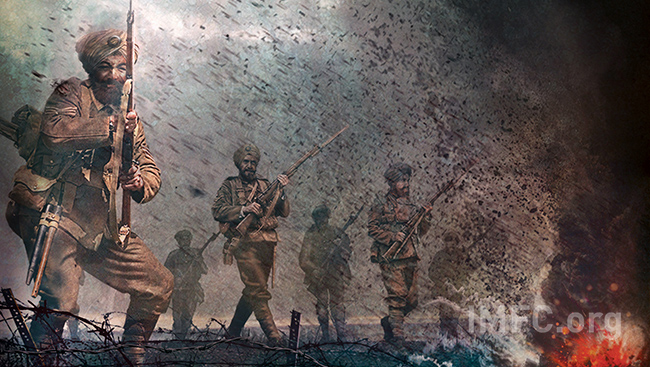Echoes of War & Rebellion
In the summer of 1914, Germany stood ready with a war machine designed to re-address the balance of power in Europe. Britain's focus on the oceans and naval supremacy had left it vulnerable on land. So acute was this deficit that German leader, Kaiser Wilhelm II, famously belittled Britain’s infantry referring to it as ‘that contemptible little army’. At the time, the British Indian Army represented the only other professional army that the Crown could call upon up in time of need. The Indian Army had served the Crown loyally throughout the Victorian period, with recruitment policies centered around martial race doctrines, which made for a clear
Northern Indian bias. No less than 3/4 of that army was now comprised of men from the Punjab, North West Frontier Province (which until 1907 was part of the Punjab) and Nepalese Gurkhas - and amongst these contingents the Sikhs were the majority.
As fate would have it, the steadfast loyalty of the Punjabis, forged under Queen Victoria and courted by King George V at his Delhi Durbar in 1911, was tested the very moment the crown needed Punjab the most. In May 1914 events were unfolding outside of India that had given rise to another type of Punjabi soldier - one that would challenge the bond between the ruler & the ruled - a soldier of the Ghadar Party - a soldier committed to the violent overthrow of the British in India.

The Canadian Connection
The Ghadar party was formed in 1913 by Indian intellectuals based in California, to liberate India from British rule. It found fertile ground for its manifesto amongst disaffected Sikhs in British Columbia. By the turn of the 20th century, Punjab’s humble peasantry emboldened by transnational citizenship of empire had ventured west to Canada only to encounter wide spread discrimination. Many were veterans of the British Indian Army, whose faith in the Crown had been shattered in the realization that though, as British subjects they were equal to whites in law, in reality they were anything but. Tensions peaked in Vancouver in May 1914 with the Komagata Maru incident. The ship carrying mostly Sikh passengers was denied landing in Vancouver on legal technicalities blatantly contrived to keep Indians out of Canada. In July, British authorities wary of how events in Canada could inflame political turmoil in India, ordered the ship back to India. An armed Canadian vessel escorted the passenger ship out of Canadian waters - though strict instructions had been given not to fire upon it. Authorities were well aware that the Ghadar party would use any flash point to rally support for its cause. As such they sought to dismantle the party's operations, and in the ensuing covert operations Bhag Singh, a British Indian Army veteran and President of the Khalsa Diwan Society was shot & killed in the 2nd Avenue Gurudwara, Vancouver on September the 5th. Bhag was a prominent local leader of the Ghadar party. The Sikhs held William Hopkinson, a police inspector formally of Calcutta, India, now assigned with surveillance of the Indian community in Canada, accountable for the murder.

A Matter of Honour
Meanwhile the agenda for the majority of Indian Sikhs in 1914, as with most Indians at that time, lay in claims for equality with Britain's white Dominions. Indian nationalist leaders of the time, including Gandhi, speculated support for war would advance their demands for greater freedoms. Under such endorsements, British India and the princely states within it would go onto offer men, raw resources and money for the war effort. Intellectuals and radicals abroad however, wanted nothing less than the removal of Britain altogether and schemed to unravel the ties that bound Sepoy to Sahib. The question of which faction would prevail loomed large on the eve of war; if Ghadar operatives were able to instigate an uprising in the villages of Punjab, the 'slave soldiers' of the Sikh regiments might well mutiny.
The British Indian Army had an Achilles heel; the colour bar the Punjabi civilians encountered in Canada had a counterpart in British military policy. Indian troops were prohibited from raising arms against white men.
The policy had been implemented in the South African Boar War of 1899-1902. During this campaign the hitherto celebrated Victorian British Indian Army had been reduced to a non-combatant role of Aide-De-Camp.
This slight weighed heavy on the Punjabi Soldiers. A notion to preserve racial superiority lay at the heart of the imperial policy; white men could not under any circumstance appear vulnerable to brown men - even if they were enemies of the crown. Punjabis had stood toe-to-toe with Europeans in the fields of Chillanwala, once in 1849 and once in antiquity when Punjabi King Porus had confronted Alexander the Great on the very same ground. The Punjabis knew they were more than a match for any European and they desired the chance to prove it again in battle.

The call to mobilize came within days of Britain’s declaration of war. An Indian Expeditionary Force (IEF) would be sent to overseas to relieve the British battalions at the Suez Canal, freeing them to join the British
Expeditionary Force (BEF) in France. However, during the last week of August, conditions on the ground in Europe were dire; overpowered by the Germans, the BEF was on the retreat. Britain needed her empire to rally to its defense but the only imperial soldiers available were the Indians. With her back against the wall, Britain would lift the colour bar and King George would make an appeal directly to the Indian soldier to uphold the Izzat of the Empire against "an aggressive and relentless enemy.. shoulder to shoulder with their comrades from all parts of the empire". The imperial authorities had calculated that the lifting of the colour bar and the appeal to Punjabi honour would drown out the rebel calls for mutiny which were mounting by the day. They calculated correctly; if the Sirkar could do this for the army then India's demands for equality with the white dominions was within realms of possibility - or so went the thinking.
A Tryst with Destiny
Thus enroute to the Suez Canal, Indian Expeditionary Force A (IEF-A) was cleared to sail on for Europe and by a quirk of fate, it would land in France on September 26, the very same day the Komagata Maru anchored in Indian waters. On landing, 'soldiers' of Ghadar were pitted against Imperial soldiers in a violent riot; 20 passengers were killed and many others were imprisoned for the duration of the war. Other Ghadarites from across the globe would also return to India only to fail to incite the local populace into a people’s rebellion. The peasantry of Punjab remained loyal and its soldiers would report for duty. For most Punjabis, to turn their backs on the British request in their hour of need would simply have been dishonourable. Some, no doubt were unaware of the wider implications of their actions, that perhaps at that moment they held the fate of the entire empire in their hands. Duty bound by obligation of the oaths they had taken, theirs was not to question why. As with the Europeans, there was an assumption that war would be over by Christmas so thoughts of winning glory for their regiments abounded. Fate would still add another twist in the story of loyalist and radical. On October 21st Mewa Singh assassinated Hopkinson on streets of Vancouver, just as IEF-A first entered the line of fire in Europe - karma, it would seem, hand another hand to play in upholding the traditions of Izzat for all true sons of the land of five rivers.
First Blood
The Jalandhar & Ferozpur Brigades of the Lahore Division (IEF-A) were the first to land in France to a rapturous welcome by the locals. Amongst them were regiments that traced their blood lines to the kingdom of Punjab, having been raised at the end of the Anglo Sikh wars from the disbanded Khalsa regiments. By the end of August the BEF had been forced to retreat from the Belgian town of Mons, and by October they were on the verge of collapse as Germany pressed on with superior infantry and artillery. The Kaiser had commanded his troops to “take Calais at all costs”; the key port of the English Channel was a lifeline to the new British army and the Canadians that were being staged to enter Europe. The IEF would arrive just in time to shore up the BEF assuming control 1/3 of the British line, the last line of defense before Calais. With the fate of the ports and the BEF in their hands the IEF-A would not falter. Seizing the moment to prove themselves the equal of any European, the Punjabis stood stoic in the face of a mighty German advance.

By the end of November 1914, the First battle of Ypres had been won. With the German advance thwarted, the opposing armies would dig themselves in, completing a series of trenches that stretched south from the
Flanders coast to Switzerland. This Western Front would remain more or less in place for the remainder of the war. IEF-A would go onto fight the 2nd Battle of Ypres in April 1915 alongside the Canadians, who, with Calais secure, began landing in France at the end of December 1914. The Canadians would also find their moment in time here on the northern end of the Western Front, at Vimy Ridge and Passchendaele (the 3rd battle of Ypres) in 1917.
Beyond Flanders Fields
IEF-A infantry regiments were withdrawn from the Western Front by the end of 1915 to secure another key win for the British - in the fight against the Ottoman Turks (Germany's ally) Baghdad was deemed an imperative and was assigned to Indian Expeditionary Force D. IEF’s B & C had been deployed against German colonies in Africa; IEF E & F would fight in Sinai & Palestine and the Suez Canal. IEF G was assigned to Gallipoli – echoing a chapter in the IEFA story – the gallantry & sacrifice of IEF G 14th Sikhs regiment would be lost to time even as the Australians went on to mark that campaign annually as their nation's founding moment. By war's end more than 1 million Indians had served overseas in the 'Great War for Civilization' and more than 74,000 fell for King and empire, an empire within which they sought dominion status.
Lest We Forget
On the centennial of WW1, we need to honour all soldiers of the King that fought for empire & British civilization, a civilization that provided the foundations of the freedoms and democracy we all enjoy today in Canada.
As Punjabis we need to honour our brave jawans that fell in this the 'Great War for civilization'; the all volunteer Indian army won more than 11,000 awards for valour, of which nearly 5,000 were British (including 11 Victoria Crosses) and over 500 European, while upholding the the Izzat of India on a global stage. This is a history shared between the mainstream and our minority. It is a dialogue around the ties that bind; a common heritage to build upon, a foundation for a joint future within a multicultural Canada.





